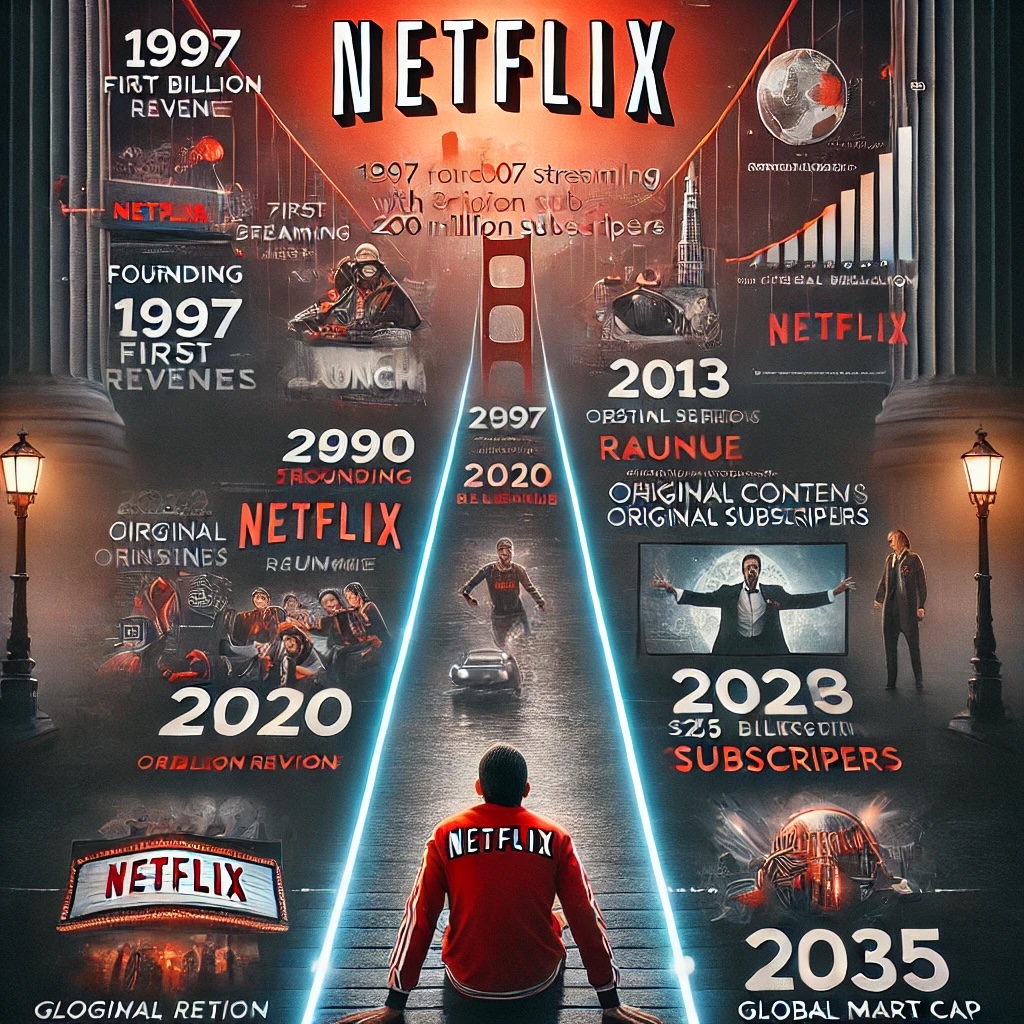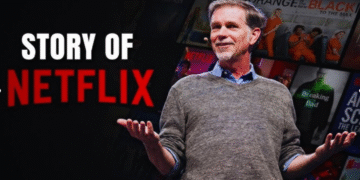The journey of Netflix is one of the most fascinating success stories in the world of business and entertainment. What started as a simple DVD rental service in the late 1990s transformed into a global entertainment powerhouse, redefining how people watch movies and TV shows. Netflix didn’t just adapt to changing technology; it shaped the way we consume content. Today, it’s a symbol of innovation, resilience, and adaptability — qualities that every modern business can learn from. The Netflix success story is more than just about profits; it’s about changing habits, embracing change, and staying ahead of trends in a world that never stops evolving.
Back in 1997, when Reed Hastings and Marc Randolph founded Netflix in California, the concept was simple but revolutionary for the time. The founders wanted to create an easier and more convenient way for people to rent movies. At that time, movie rentals were dominated by Blockbuster, a chain that required people to visit physical stores, pick up VHS tapes or DVDs, and return them on time to avoid late fees. Netflix, however, had a different idea. They built an online platform where customers could order DVDs through the internet and have them delivered right to their doorstep via mail. It was fast, easy, and free from the hassle of late fees.
Netflix launched its DVD-by-mail service in 1998 with about 925 titles available, and within a year, it began attracting movie lovers who wanted more flexibility. What really set Netflix apart from competitors was its subscription model introduced in 1999. Instead of paying per rental, customers could pay a flat monthly fee and rent as many DVDs as they wanted with no due dates or late fees. This innovation not only disrupted the rental market but also created loyal subscribers who loved the convenience.
However, the company didn’t stop there. By the early 2000s, Netflix started investing heavily in technology. It developed a recommendation system that used data analytics to suggest movies based on users’ viewing habits. This algorithm became one of Netflix’s secret weapons, increasing customer satisfaction and engagement. People started trusting Netflix to help them find what they loved to watch, and the more they watched, the better Netflix got at predicting their preferences.

Despite its growing popularity, Netflix faced significant challenges in the early years. The dot-com bubble burst in 2000, and many internet-based companies collapsed. But Netflix survived because its business model was practical, customer-centric, and adaptable. Reed Hastings even offered to sell Netflix to Blockbuster in 2000 for $50 million, but Blockbuster declined. That decision later became one of the most infamous mistakes in business history because Netflix would eventually rise to dominate the very market that destroyed Blockbuster.
By 2005, Netflix had over 4 million subscribers in the United States, and its growth was unstoppable. But the real turning point came in 2007 when Netflix introduced video streaming. This was the moment when everything changed. The world was moving toward high-speed internet, and streaming allowed people to watch movies and shows instantly without waiting for DVDs to arrive in the mail. This was not just innovation — it was a revolution. Netflix became one of the first companies to capitalize on the growing trend of on-demand entertainment, and it soon phased out its DVD-by-mail business to focus on digital streaming.
The timing couldn’t have been better. Devices like smart TVs, gaming consoles, and smartphones were becoming more common, and people wanted flexibility in how they watched entertainment. Netflix made it possible to stream anytime, anywhere. By 2010, it had expanded beyond the U.S. to Canada, and soon after, it launched in Latin America, Europe, and Asia, turning itself into a global brand.
What made Netflix stand out during this global expansion was its focus on content. In the early years of streaming, Netflix licensed movies and TV shows from other production companies. However, it quickly realized that relying on others for content wasn’t sustainable. So in 2013, Netflix made a bold move by producing its own original show — House of Cards.The political drama starring Kevin Spacey and Robin Wright was an instant hit and marked the beginning of Netflix Originals. The success of House of Cards proved that Netflix could not only distribute content but also create it.
This move into original programming changed the entertainment industry forever. Soon after, Netflix released Orange Is the New Black, Narcos, and Stranger Things, each of which became cultural phenomena. The company began investing billions of dollars into creating diverse content across genres and languages. From Hollywood blockbusters to international hits like Money Heist and Squid Game, Netflix became the world’s biggest content creator and distributor. Its global strategy — “think global, act local” — helped it dominate markets across continents.
Netflix also embraced data-driven decision-making to guide its creative process. The company used sophisticated algorithms to analyze viewer data and trends to determine what kind of shows or movies audiences wanted. This helped minimize risk and maximize engagement. The focus was not just on what people watched but how, when, and where they watched it. These insights gave Netflix an edge that no traditional studio could match.
But success didn’t come without challenges. As streaming became more popular, competitors like Amazon Prime Video, Disney+, Hulu, and HBO Max entered the market, leading to what’s now known as the “streaming wars.” Each platform began investing heavily in exclusive content, and licensing deals became more expensive. Yet, Netflix continued to innovate. It expanded into interactive storytelling with Black Mirror: Bandersnatch, experimented with mobile-only plans in certain regions, and introduced features like “Download for Offline Viewing” to enhance user experience.
Another major factor behind Netflix’s success was its marketing and branding. Netflix understood the power of social media and digital word-of-mouth. It used memes, teasers, and audience engagement strategies to create hype around new releases. Campaigns like those for Stranger Things and The Witcher turned ordinary shows into global events. Netflix also localized its marketing to appeal to different audiences — a Spanish viewer would see different highlights than someone in Japan or the U.S., all driven by intelligent algorithms.
The COVID-19 pandemic in 2020 further accelerated Netflix’s growth. As theaters closed and people stayed home, Netflix became the world’s main source of entertainment. It added millions of new subscribers and saw record engagement levels. Shows like The Queen’s Gambit, Tiger King, and Money Heist became viral sensations, dominating conversations worldwide. Netflix didn’t just survive the pandemic — it thrived.
Today, Netflix is much more than a streaming service. It’s a technology company, a content creator, and a cultural force that shapes global entertainment. It produces films that win Oscars, documentaries that spark debates, and series that create global fan communities. It has changed not only how people consume entertainment but also how creators make it.
The secret behind Netflix’s success lies in its ability to evolve. From DVDs to digital streaming, from licensing content to creating original productions, and from a U.S.-based startup to a global entertainment empire, Netflix has continuously reinvented itself. The company embraces innovation, takes calculated risks, and listens to its users — values that every business should learn from.
Looking ahead, Netflix faces new challenges such as rising competition, password-sharing restrictions, and the need to continuously create high-quality content in a saturated market. Yet, its history shows that adaptation and innovation are in its DNA. With a growing focus on gaming, live streaming, and interactive content, Netflix is once again redefining the future of entertainment.
Netflix’s success story is an inspiring reminder that no company is too small to change the world. What began as a simple DVD-by-mail service has turned into a streaming revolution that has transformed the global entertainment landscape. Through innovation, data-driven strategies, and relentless focus on customer satisfaction, Netflix didn’t just follow trends — it created them. Its journey from DVDs to TV shows, and now to being a cultural icon, proves that when you dare to dream differently and adapt fearlessly, success is not just possible — it’s inevitable.
















